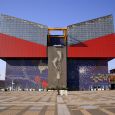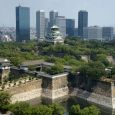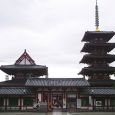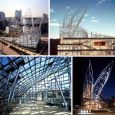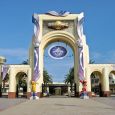Osaka
Advertisement
By plane
The main international gateway to Osaka is Kansai International Airport (IATA: KIX). The airport has two railway connections to the city: JR West's Kansai Airport Line and the private Nankai Electric Railway.
Most domestic flights arrive at Osaka International Airport, also known as Itami Airport (IATA: ITM). Itami is connected to the Osaka Monorail, but the monorail is expensive and traces an arc around the northern suburbs, so to get to the centre of the city you will need to transfer to a suburban Hankyu railway line. A more convenient option for most are the Airport Limousine Buses, which run frequently from Itami to various locations within Osaka and elsewhere in the region , with fares starting around ¥500-600. Taxi from Itami airport to Osaka castle area costs ¥4000 plus ¥700 for toll road.
By train
Tokaido and Sanyo Shinkansen trains arrive at Shin-Osaka station, to the north of the city center. From Shin-Osaka, you can connect to the city center by using the Midosuji subway line, or connect to the local JR network for other destinations.
From Tokyo, Nozomi trains cover the one way ride in about 2 1/4 hours Hikari trains take 3 hours and all-stopping Kodama trains take 4 hours. With the Japan Rail Pass, there is no charge to take the Shinkansen if you use the Hikari or Kodama service.
From points west of Osaka, Nozomi trains run from Okayama , Hiroshima and Hakata station in Fukuoka . Japan Rail Pass holders can use the Hikari Rail Star service instead, which runs at a comparable speed to the Nozomi and makes a few more stops, but its trains are shorter. Slower Kodama trains connect the rest of the stations on the route.
By car
It is generally a bad idea to use an automobile to visit Osaka. Many streets do not have names, signs are usually only in Japanese, and parking fees are astronomical. In addition, an international driver's license is required.
By bus
As Osaka is a major city, there are many daytime and overnight buses which run between Osaka and other locations throughout Japan, which can result in significant savings when compared to shinkansen fares.
The JR Bus Group is a major operator of the routes from the Tokyo area to Kansai. Buses operate via the Tomei Expressway or the Chuo Expressway.
By boat
Osaka International Ferry Terminal is located at Nanko in the Osaka Bay Area. There are no banks, post office, shops, or restaurants in the terminal. The nearest subway station is Cosmosquare Station (C11), which is about a 15 minute walk from the terminal. A free shuttle bus is available at the station. Taxis are also available at the station.
National Museum of Art
The National Museum of Art is a subterranean Japanese art museum located on the island of Nakanoshima, located between the Dojima River and the Tosabori River, about 5 minutes west of Higobashi Station in central Osaka.
The official Japanese title of the museum translates as the "National Museum of International Art". The museum is also known by the English acronym NMAO (National Museum of Art, Osaka).
Universal Studios Japan
Universal Studios Japan located in Osaka, is one of four Universal Studios theme parks, owned and operated by USJ Co,. Ltd. The park is similar to Universal Orlando Resort, since it contains many of the same rides. Most visitors are Japanese tourists or tourists from other Asian countries such as Taiwan, Hong Kong, and South Korea. In 2005 Goldman Sachs became the largest shareholder in Universal Studios Japan. Universal still has a small minority stake in the park. The park opened on March 31, 2001. 11 million guests entered Universal Studios Japan in its first year of operation, the fastest any park reached that milestone.
Osaka Aquarium Kaiyukan
The Osaka Aquarium Kaiyukan is an aquarium located in the ward of Minato in Osaka, Japan, near Osaka Bay. It is one of the largest public aquariums in the world,and is a member of the Japanese Association of Zoos and Aquariums (JAZA).
The aquarium is about a five minute walk from Osakako Station on the Osaka Municipal Subway Chuo Line, and is next to the Tempozan Ferris Wheel.
Osaka Castle
Osaka's best known sight, although it's a concrete reconstruction that pales in comparison with, say, Himeji. Think of it as a museum built in the shape of a castle, rather than as an actual historical castle. Still, it's pretty enough from the outside, especially in the cherry blossom season when Osakans flock to the castle park to picnic and make merry. Naniwa Palace Site Park or Naniwanomiya can also be found south to Osaka Castle Park (although it's one of Japan's oldest habitats and palace sites, today it's little more than an empty grass field where the outlines of Naniwa's palace foundations from around 643 AD have been partly recreated in concrete). The grounds are free, and the castle costs adults ¥600, children free.
Tsutenkaku
While the original tower was built early 20th century, the current "newer" version is designed by the same Prof. Naito, who also designed Tokyo Tower. This landmark built in the middle of the Shinsekaiarea is a symbol of reconstruction of the City of Osaka post WWII. There's a "Sky Billiken" on the platform, definitely makes your wishes come true, once you rub his feet! And if you are lucky, your guide will have another job as a comedian! Trip to the top ¥600, ouside platform with guide and safety belt extra ¥1400.
Sumiyoshi Shrine
One of Japan's oldest Shinto shrines, with a history stretching back 1800 years. Its traditional architecture is unusual amongst Japan's shrines, and its park-like surroundings with the sacred bridge arching over a tranquil pond make it a restful break from the busy environment of Osaka. Free.
Shitennoji Temple
Originally built by Emperor Suiko in 593 AD. Although the current buildings are mostly post WWII reconstructions, the temple is a rare sample which conveys the continental style (notably the positioning of the individual buildings inside the complex) of 6th-7th century to present.
April - November


